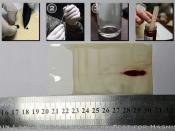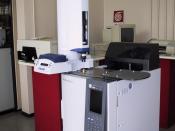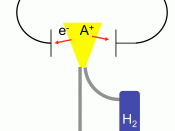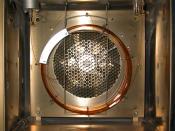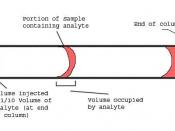IntroductionChromatography is a commonly used process used to separate compounds based on their different interactions with other substance. It is affected by the compoundsÃÂ chemical and physical properties. The mixture (mobile phase) is passed through a stationary phase within the column. Based on the chemicalsÃÂ interactions with the stationary phase, they will elute out with different times. The time taken is dependent on the degree, strength, and type of interaction. Hence, the compounds will be separated.
Gas chromatography, or gas-liquid chromagraphy which is used in this experiment, consists of two phases. The mobile phase is an inert gas (like helium, argon, or nitrogen) and the stationary phase is a liquid (either directly on the walls of the column or adsorbed onto a coating). The basic components are carrier gas system, sample injection system, column oven, and detector. The carrier gas system controls the mobile phase, adjusting the flow rate and pressure.
The sample injection injects the sample into the column, with parameters like split ratio being controlled. The column oven adjusts the temperature of the column, usually using temperature programming, which varies the temperature over time. The detector detects the product that is eluted; types include flame ionization and thermal conductivity.
MethodSample preparationThe previously prepared sample consists of a few alcohols. The sample (1 uL) was extracted and injected into the vaporization chamber.
Gas chromatographyThe temperature was 200oC with split ratio of 1/50. After being injcted into the chamber, the sample was directed to the capillary column coated with stationary phase, polyethylene glycol. The mobile phase was helium gas. Temperature programming was used, with initial temperature of 55oC for 3 minutes, increasing at a rate of 10oC per minute and final temperature of 150oC. The flame ionization detector was set at 200oC.
Data analysisThe LC solution software was used to plot intensity versus time based on amount eluted and retention time. The graph was compared against a calibration graph, obtained previously with different peaks identified as different alcohol.
ResultsCalibrated standardRetention time (min)Alcohol6.574t-amyl10.1132-pentyl10.8371-pentyl11.808cyclopentyl12.4611-hexylMy resultsRetention time (min)Alcohol6.643t-amyl10.1422-pentyl11.833cyclopentylThe results, with peaks at 6.643 min, 10.142 min, and 11.833 min indicate that the alcohols are t-amyl, 2-pentyl and cyclopentyl alcohols respectively.
DiscussionThe experiment shows that retention times do not differ much for Gas Chromatography as the samples generally interact similarly with the mobile phase.
The gas chromatography method is very useful for research. It can be used to isolate unknown compounds from various outfield sources, concentrating and isolating the unknown compound prior to structure analysis.
It is also used in crime investigation where gas chromatography analyses the compounds found on-site. The evidence left behind can be investigated to find out what substances are present.
However, without a standard calibration graph, it is difficult to determine what exactly the compound is. That is the primary limitation of gas chromatography. So it is often used in conjunction with other analysis techniques like mass spectroscopy.
ConclusionGas-liquid chromatography can be used to effectively separate and identify alcohols from a mixture.
ReferencesSkoog (2004). Fundamentals of Analytical Chemistry. Belmont, California: Thomson-Brooks Cole.
